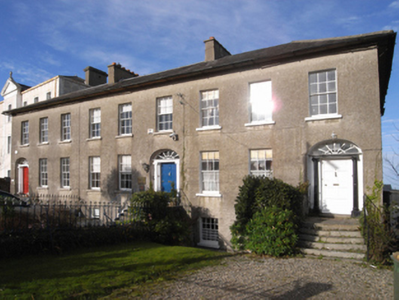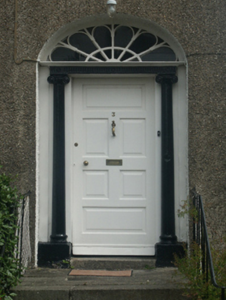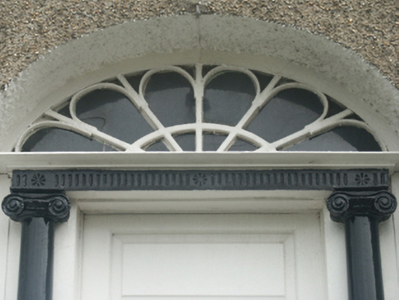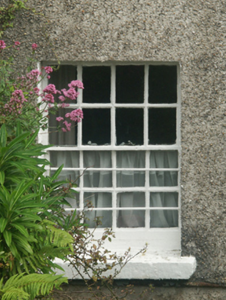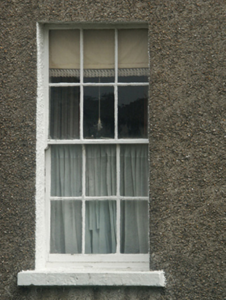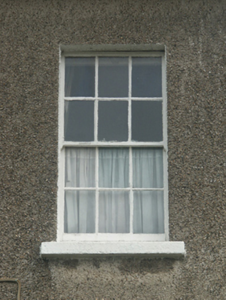Survey Data
Reg No
15500008
Rating
Regional
Categories of Special Interest
Architectural, Artistic
Original Use
House
In Use As
House
Date
1855 - 1860
Coordinates
304164, 122353
Date Recorded
23/06/2005
Date Updated
--/--/--
Description
End-of-terrace three-bay two-storey over part raised basement house, extant 1862, on a rectangular plan; three-bay full-height rear (north) elevation. Occupied, 1901; 1911. One of a terrace of three forming part of a group of five. Flat topped pitched and hipped slate roof with clay ridge tiles, cement rendered chimney stack (west) having concrete capping supporting terracotta pots, and cast-iron rainwater goods on slate flagged eaves retaining cast-iron downpipes. Roughcast walls. Segmental-headed door opening (east) approached by flight of six cut-granite steps between wrought iron railings, doorcase with three quarter-engaged Ionic pillars on cut-granite plinths supporting shallow cornice on "patera"-detailed fluted frieze, and concealed dressings framing replacement timber panelled door having fanlight. Square-headed window openings with cut-granite sills, and concealed dressings framing eight-over-eight (basement) or six-over-six timber sash windows. Square-headed window openings to rear (north) elevation with cut-granite sills, and concealed dressings framing six-over-six timber sash windows. Interior including (ground floor): hall (east) retaining carved timber surrounds to door openings framing timber panelled doors, moulded plasterwork cornice to ceiling, staircase on a dog leg plan with turned timber balusters supporting carved timber banister, carved timber surrounds to door openings to landing framing timber panelled doors, and moulded plasterwork cornice to ceiling; reception room (south-west) retaining carved timber surround to door opening framing timber panelled door with carved timber surrounds to window openings framing timber panelled shutters on panelled risers, "Faience Majolica"-tiled Classical-style chimneypiece, and picture railing below moulded plasterwork cornice to ceiling; reception room (north-west) retaining carved timber surround to door opening framing timber panelled door with carved timber surrounds to window openings framing timber panelled shutters on panelled risers, and picture railing below moulded plasterwork cornice to ceiling; and carved timber surrounds to door openings to remainder framing timber panelled doors with carved timber surrounds to window openings framing timber panelled shutters on panelled risers. Set back from street with cut-granite chamfered piers to perimeter having stringcourses below shallow pyramidal capping supporting "Fleur-de-Lys"-detailed wrought iron double gates.
Appraisal
A house erected by Walter Eakins (----) of Richmond House (see 15500003) representing an important component of the mid nineteenth-century domestic built heritage of Wexford with the architectural value of the composition confirmed by such attributes as the compact rectilinear plan form; the Classically-detailed doorcase not only demonstrating good quality workmanship, but also showing a simplified "peacock tail" fanlight; the diminishing in scale of the openings on each floor producing a graduated visual impression and the slightly oversailing roofline. Having been well maintained, the elementary form and massing survive intact together with substantial quantities of the original fabric, both to the exterior and to the interior where contemporary joinery; restrained chimneypieces; and plasterwork refinements, all highlight the artistic potential of a house forming part of a self-contained ensemble (including 15500006 - 15500007; 15500009 - 15500010) making a pleasing visual statement in Spa Well Road. NOTE: Occupied (1901) by William Elgee (1841-1910), 'Retired Lieutenant Colonel Royal Army Medical Corps' (NA 1901); and (1911) by Nicholas Keating (1847-1915), 'Retired First Class Officer [of] Customs and Excise Inland Revenue Department' (NA 1911).

